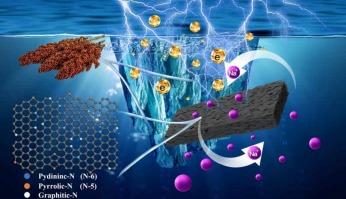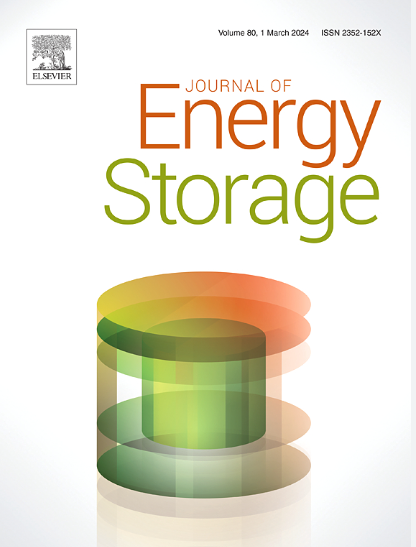自掺杂多孔高粱壳衍生碳作为低温下高性能钠离子电池的阳极
IF 8.9
2区 工程技术
Q1 ENERGY & FUELS
引用次数: 0
摘要
硬碳(HC)被广泛认为是最有前途的钠离子电池(SIB)阳极材料之一,但它仍然面临着几个关键挑战,包括容量低、速率能力差和初始库仑效率低。为解决这些问题,本研究利用天然掺氮生物质废料高粱壳作为优质碳源,制备多孔碳氢化合物材料作为钠离子电池的阳极。这种自掺杂策略可促进电子/离子传输,提高电解质润湿性,并显著改善钠储存性能,尤其是在低温条件下。合成的阳极电极在-20 °C时表现出卓越的性能,在50 mA g-1的条件下,比容量高达322 mA h g-1,初始库仑效率为91%。该材料丰富的多孔结构确保了长期循环稳定性,在 1 A g-1 条件下循环 600 次后,其容量仍能保持在 150 mA h g-1 以上。此外,循环伏安法(CV)测试结果和电静电间歇滴定技术(GITT)证实,钠离子的传输主要是由扩散控制的,这表明该材料具有出色的速率能力。本文章由计算机程序翻译,如有差异,请以英文原文为准。

Self-doped porous sorghum husk-derived carbon as anode for high performance sodium-ion batteries at low temperatures
Hard carbon (HC) is widely regarded as one of the most promising anode materials for sodium-ion batteries (SIBs), but it still faces several key challenges, including low capacity, poor rate capability, and low initial Coulombic efficiency. To address these issues, in current study, naturally N-doped biomass waste sorghum husk is utilized as a high-quality carbon source to fabricate porous HC materials as anodes for SIBs. This self-doped strategy facilitates electron/ion transport, enhances electrolyte wettability, and significantly improves sodium storage performance, particularly at low temperatures. The synthesized anode electrodes exhibit outstanding performance at −20 °C with a high specific capacity of 322 mA h g−1 at 50 mA g−1 and an initial Coulombic efficiency of 91 %. The abundant porous structure of the material ensures long-term cycling stability, maintaining a capacity of over 150 mA h g−1 after 600 cycles at 1 A g−1. Additionally, the cyclic voltammetry (CV) test results and galvanostatic intermittent titration technique (GITT) confirm that the sodium ion transport is primarily diffusion-controlled, indicating excellent rate capability.
求助全文
通过发布文献求助,成功后即可免费获取论文全文。
去求助
来源期刊

Journal of energy storage
Energy-Renewable Energy, Sustainability and the Environment
CiteScore
11.80
自引率
24.50%
发文量
2262
审稿时长
69 days
期刊介绍:
Journal of energy storage focusses on all aspects of energy storage, in particular systems integration, electric grid integration, modelling and analysis, novel energy storage technologies, sizing and management strategies, business models for operation of storage systems and energy storage developments worldwide.
 求助内容:
求助内容: 应助结果提醒方式:
应助结果提醒方式:


